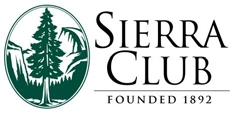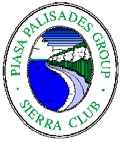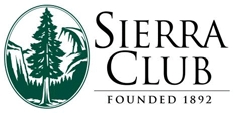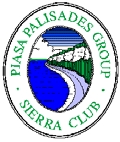PIASA PALISADES GROUP
223 Market Street . Alton, IL 62002-6231 . TEL: (618)462-6802 . FAX: (618)462-0282
www.Illinois.SierraClub.org/PiasaPalisades
Illinois Pollution Control Board
September 14, 2007
ATTN: Clerk of the Board
100 West Randolph Street
James R. Thompson Center Suite 11-500
Chicago, IL 60601-3218
RE: AS 2007-2
Dear IPCB:
Thank you for the opportunity to comment on the adjusted standard for the Illinois-American Water
Company’s Alton Public Water Supply Facility. The Sierra Club considered this proposal before the first adjusted
standard was issued. We adopted a neutrality position. That position still stands as the Sierra Club has problems
with granting the adjusted standard and problems with the consequences of not granting it.
We wish to clarify the comments made at the hearing. We also need to point out that while the Sierra Club
was signed onto the August 21, 2007, letter by ELPC, the Sierra Club procedures were not followed. The ELPC
letter did not represent the position of the Sierra Club that had been adopted by our Group’s Executive Committee in
accordance with Sierra Club rules. While our national water committee has verified the concerns listed in the letter
are concerns of the Sierra Club, that letter does not represent all the concerns of the Club. It’s request for denial of
the permit is contrary to the Sierra Club’s neutrality on the permit. We recognize this is a very unique situation with
no easy answers since the water plant is located along the Meeting of the Great Rivers National Scenic Byway
1
and
the Alton Lake Heritage Parkway. We believe the IPCB’s decision needs to recognize that this is a very unique
situation since the dirt would have to be hauled through Piasa Park (where the Piasa Bird is located), across the Sam
Vadalabene Bike Trail, and down the National Scenic Byway. The Sierra Club has problems with granting the
1
The management plan for the Byway can be downloaded at:
http://www.greatriversbyway.com/docs/CVB_CMPbook.pdf
Electronic Filing, Received, Clerk's Office, September 14, 2007
* * * * * PC #7 * * * * *
PIASA PALISADES GROUP
223 Market Street . Alton, IL 62002-6231 . TEL: (618)462-6802 . FAX: (618)462-0282
www.Illinois.SierraClub.org/PiasaPalisades
adjusted standard as well as the consequences of denying the adjusted standard. We hope the IPCB can find a way
to adequately address all our concerns. We recognize that is not an easy task and may not be possible. We hope
this clarifies where the Sierra Club stands.
Besides the concerns (other than the request to deny the adjusted standard) listed in the August 21, 2007, letter, the
Sierra Club has the following concerns:
For the area of the permit, the Alton Lake Heritage Parkway Corridor Law states:
The Illinois General Assembly finds:
(a) that the Mississippi River from Alton to Grafton is recognized as the most beautiful portion of
the entire River;
(b) that Alton Lake and the majestic limestone bluffs on this parkway corridor are irreplaceable
assets;
(c) that the scenic,
cultural,
historical,
geological, archaeological, ecological, and
recreational resources in this part of the Mississippi River Valley are international attractions which
should be more appreciated;
(d) that preservation of the Native American heritage in this area, especially remains and cemeteries
(including mounds), must be assured;
(e) that public opinion is overwhelmingly in favor of preserving and protecting this scenic,
natural, and cultural heritage;
(f) that the best interests of the State of Illinois will be served by this protection;
(g) that current procedures for this protection are inadequate; and
(h) that numerous State, federal, and private agencies are much interested in this parkway
corridor.
20 ILCS 3905/1002
The Sierra Club was the major force behind the passage of this law. We also worked for National Scenic
Byway Status. For decades, the Sierra Club has fought for protection of this unique and special area. We have
supported a Great Rivers National Recreational Area. The Sierra Club’s Midwest Region Conservation Committee
proposed a Great Confluence Reserve for this area. Our Group proposed a Mississippi River Heritage Parkway for
Electronic Filing, Received, Clerk's Office, September 14, 2007
* * * * * PC #7 * * * * *
−3−
this section of the River. The Sierra Club supports the on-going effort to designate the area The Confluence
National Heritage Area.
Over the last decade many millions of dollars have been spent by public and private sources to acquire
scenic easements, conservation easements, and land along the Byway/Parkway. Just recently several million were
spent to acquire the Palisades property. Many millions more of public and private money has been spent for new
parks, facilities, scenic improvements, etc. along the Parkway.
The Sierra Club has filed three lawsuits over the area. The first was over the water park. While the suit was
not successful in stopping the eyesore water park, the battle to stop the water park resulted in the effort to obtain the
Alton Lake Heritage Parkway and Meeting of the Great Rivers National Scenic Byway. These efforts also resulted
in the money spent to protect and enhance the area. In the 1970's we sued the Army Corps of Engineers over barge
fleeting along the area that is now the Byway. We opposed it because of it impact to the scenic beauty of the area.
We also sued the Army Corps of Engineers seeking to force them to clean up an area along the Byway that was
leased for a commercial harbor that was an eyesore. We sought cancellation of the lease and the area turned into a
park.
We recently convinced the Corps of Engineers to force the a permit holder (across from Piasa Park) to clean
up their barges along the Byway. We have tried to get the Corps to revoke the permit and move off the Byway. We
opposed the permit in the first place. The Alton Telegraph ran an editorial saying they should be forced to move.
We have encouraged IDOT to treat the area with extreme care. The Sierra Club has adopted a portion of the Byway
for litter clean up. The Sierra Club has also had bike and canoe outings on the Byway. Our members regularly use
and enjoy the Byway. We could go on and on with all the things we have done to protect the area.
The Sierra Club is opposed to all truck traffic (other than pick ups) on the Byway. Therefore, the Sierra
Club is opposed to truck traffic from the water plant hauling off dirt along the Byway. We have long opposed truck
traffic on the Byway. When IDOT proposed lifting the weight limits in Grafton, the Sierra Club opposed this as it
would allow big trucks on the Byway between Alton and Grafton. We do not want trucks hauling dirt coming
through Piasa Park, across the Sam Vadalabene Bike Trail, and then down the Alton Lake Heritage Parkway.
Piasa Park contains the Piasa Bird and tells the Native American legend about this bird. It is a major tourist
stop and a nice park. It is also a major parking area for the Sam Vadalabene Bike Trail. The Sam Vadalabene Bike
Trail runs from Piasa Park along the National Scenic Byway. It ends about 20 miles latter in Pere Marquette State
Park-the crown jewel of Illinois’ parks. This is a heavily used bike trail that can have traffic jams. The Sierra Club
supported the creation of this bike trail and many other bike trails. This bike trail is also now connected with
hundreds of miles of bike trails in the St. Louis Area. The Management Plan for the National Scenic Byway states:
Travel on the byway is safe. Accommodations for bicyclists and pedestrians are provided along the
Vadalabene, Alton and Confluence Bike Trails that run parallel to the byway. The byway supports
actions that would allow cyclists to return to a dedicated bike trail wherever possible. The byway
members have also expressed favor toward justifiable safety pull-offs and other safety additions.
http://www.greatriversbyway.com/docs/CVB_CMPbook.pdf
Since this section of the Byway is the most scenic part of the Mississippi River, many people want to see it. A drive
up the Byway to Grafton or Pere Marquette State Park is an extremely popular activity. In the fall, many times
there will be bumper to bumper traffic viewing the spectacular fall colors. It is the best place to view fall colors in
the St. Louis Region. In the winter Bald Eagles migrate to the area. There are usually hundreds of eagles in the
area. Once again, there will be traffic jams of people watching eagles. Eagles have also nested along the Byway. In
Electronic Filing, Received, Clerk's Office, September 14, 2007
* * * * * PC #7 * * * * *
−4−
the spring, the red buds and flowering dogwoods attract the crowds. In recent years, a new attraction has developed.
For a large part of the year, you can see thousands of pelicans flocking in the river. The Sierra Club does not
believe an area like this should have big commercial trucks. They present a safety hazard to people walking and
riding on the bike trail and to slow moving traffic on the Byway. This is particularly true for people getting out of
their car to watch eagles. Commercial truck traffic takes away from the experience of the Parkway.
The Piasa in Piasa Palisades Group is from the Piasa Bird. Palisades is from the palisades in the bluffs along
the Byway.
Our members have seen the benefits of the Great Rivers Land Trust’s Piasa Creek Watershed Project.
2
It is
an outstanding project that has accomplished many great things. Not only has this project kept dirt out of Piasa
Creek and the Mississippi River, it has had many other environmental benefits. For example, wetlands have been
created, farm chemicals are kept out, and the Boy Scouts got their lake dredged out. We want to see this project
continued.
2
www.greatriverslandtrust.com/grlt%20projects.htm
We strongly support cleaning up the Mississippi and encourage everything possible be done to keep the dirt
out of the Mississippi in the first place. We have fought hard for programs to keep the dirt out of the Mississippi.
We have opposed farming in Pere Marquettee State Park in part because it puts sediment in the Illinois River which
flows right into the Mississippi. We have opposed many of the Army Corp of Engineer Environmental
Management Program projects as they dealt with sediment in the river by building levees. We have asked that they
spend the money keeping the dirt out of the Mississippi in the first place.
Some of our additional concerns with the project include: While Illinois is the Prairie State, almost all our
prairie has been lost. Alton Water Company indicates if the permit is not granted, restored prairie will be converted
to lagoons. We are also concerned with the truck traffic’s pollution and impact on global warming. We are also
concerned with any possible impact from materials that may be discharged that were added by Alton Water
Company. We want to make sure there is no problem with additional chemicals that may be put in the river.
We also wish to point out the real problem is the sediment getting into the water in the first place. One of
the major environmental impacts of barges is the propellers stir up the sediment and resuspend it. Thus, Alton
Water Company must deal with dirt others put in the water and dirt the barges stirred up. These underlying
problems need to be addressed.
Electronic Filing, Received, Clerk's Office, September 14, 2007
* * * * * PC #7 * * * * *
−5−
It is the policy
3
of the Sierra Club that:
Environmental Quality of Settled Areas
The Sierra Club believes that careful planning is necessary in communities to maintain an
appropriate relationship between natural features and man’s works. Therefore, in general, the Club
supports programs to maintain adequate natural and scenic open space; to conserve pure air and
water; and to establish and maintain regional, county, and city parks and greenbelts. Moreover, in
principle, the Club supports the regulations of the location, size and character of advertising signs;
the screening or removal of nuisance sights; and the placement of utilities underground wherever
practical * * *
The Sierra Club is vitally concerned that the urban environment, in which a majority of this
country's residents and a majority of our members live, be healthy and stimulating since the physical
state of a city reflects the well-being of its people. * * *
Therefore, the Sierra Club urges planning and policies which stimulate:
Conservation of Open Space
Preservation of hills, coasts, wetlands, other outlying natural areas and agricultural lands by zoning,
curbing suburban highway development, control of municipal services and other devices to eliminate
"leap-frog" sprawl.
Abundant, convenient public open spaces, including parks, playgrounds and natural "unimproved"
areas. * * *
Opening up of waterfronts to public access and use. * * *
Protection and Enhancement of the Quality of Urban Life
Protection and enhancement of the quality of urban life by preservation of our architectural and
cultural heritage. * * *
3
These are quotes from policies adopted by the Club’s National Board of Directors.
Wild and Scenic Rivers
Effective wild, scenic, and recreational river protection programs should be enacted in every state
and province. Federal, state or provincial, and local programs should be fully implemented to
preserve unique areas.
E. The Right to Sustainable Environmental Benefits
Electronic Filing, Received, Clerk's Office, September 14, 2007
* * * * * PC #7 * * * * *
−6−
People are entitled to enjoy the sustainable aesthetic, recreational, cultural, historical, scientific,
educational, religious, sacred, sustenance, subsistence, cultural, and other environmental benefits of
natural resources. However, actions that tend to ruin the integrity, stability, and beauty of the biotic
community are unethical.
We support an end to pollution The long-range policy goal priorities for environmental protection
must be: (1) to end the production of polluting substances and waste through elimination,
replacement, redesign, reduction, and reuse (zero waste), (2) to prevent any release of polluting
substances (zero emissions, zero discharge), (3) to prevent any exposure of plants, animals, or
humans to polluting substances, and (4) to remediate the effects of any such exposure.
Agriculture must be carried out in an environmentally sound manner which: Protects land, soil, and
water resources and maintains their long-term productivity.
The Sierra Club supports legislation and research promoting the use of sustainable methods of
producing food and fiber, that is, methods that: Maintain healthy relationships with unmanaged
ecological communities. * * * Preserve soil tilth and beneficial soil organisms. Minimize soil
erosion and nutrient loss.
Attachment #1 is our Pollution Trading Policy
We ask the IPCB to consider these policies and we encourage the IPCB to act in furtherance of these policies. A
purpose of the Sierra Club is “to protect and restore the quality of the natural and human environment.” We hope
the IPCB’s decision will further this purpose.
Sincerely,
Jim Bensman
Conservation Chair
1802 Main Street
Alton, IL 62002
(618)463-0714
jbensman1@charter.net
Electronic Filing, Received, Clerk's Office, September 14, 2007
* * * * * PC #7 * * * * *
−7−
Attachment #1 Sierra Club Pollution Trading Policy
Pollution Trading
The Sierra Club opposes use of trading. In all cases, if a program is initiated, there must be full public notice,
disclosure, participation, oversight, accountability, verification, and effective enforcement, with rights of appeal for
affected citizens and administrative and judicial remedies.
The following conditions must apply:
that the trade produces overall gains in ambient environmental conditions;
that such gains satisfy goals set forth in approved government plans;
that reductions for trades are beyond current legal requirements, with indicated reductions being greater than 1:1 as
a hedge against uncertainty and non-compliance;
that the required reductions be new (e.g., not be taken from unused allowances);
that trading should be limited to pollutants of the same kind;
that no credit be granted for reductions from sources closed down prior to the proposal for the trade;
that the trade occur within the same local physiographic unit (e.g., watershed or airshed), except that for the
purposes of carbon dioxide, the entire atmosphere is the airshed*;
*However, a CO2 trade should not be allowable if air quality could be worsened locally or regionally as a result of
the trade (because of associated pollutants such as NOx). [That outcome would violate various other provisions of
this policy (e.g., it would like run afoul particularly of either #1, C, or D.).]
that in all cases monitoring be provided by the seller, with results reported to regulators and made public, to assure
that the required reductions actually occur; increased costs to the public of surveillance should be covered by permit
fees;
that data on these reductions is provided to the public in an easily understood format (electronically as well as in
hard copy);
that whoever cheats be punished by severe fines that are applied automatically and that surety bonds be provided,
where appropriate, as an incentive to perform; and that buyers who rely on unwarranted credits also be subject to
fines;
that information on violations remain public information and not be subject to "audit privilege" or other forms of
confidential business information; and that compliance records for all firms engaging in trading be made available to
any member of the public (and not be subject to "audit privilege"), including records on inspections and violations;
that violators will have their allowable releases reduced in the year following the violation by the amount of their
excess releases; where the amount of this excess is unknown, it should be assumed to be the maximum physically
possible;
Electronic Filing, Received, Clerk's Office, September 14, 2007
* * * * * PC #7 * * * * *
−8−
that the trader be competent to make the required reductions and that firms that have contributed materially to
ambient problems not be eligible to engage in trading;
that chronic cheaters be excluded from trading programs;
that the government retain the right to further limit allowable releases, without needing to compensate the releasor.
Permission to trade must not establish a right to pollute, nor any property interest in material that is released.
Under no circumstances should trading arrangements lead to the following:
Violation of ambient standards, expanded pollution at grandfathered sites (i.e., from old sites granted legal
exemption from meeting standards), nor significant deterioration in the quality of air and water which has been
good, nor degradation of soils, ecosystems or other public values;
Increased releases of any of the following categories of toxics (measured at the point of release): -- heavy metals --
neurotoxins -- known or suspected carcinogens -- known or suspected endocrine disrupters -- known or suspected
mutagens, or -- persistant or bioaccumulative agents;
Backsliding on pollution control obligations, nor on best management practices, nor facilitate irresponsible conduct;
Build up of levels of pollution in Clean Air Act non-attainment areas, nor make conditions worse in such areas;
Monopolization of pollution allowances;
Trading in, and between, communities that disapprove of trades that affect them. Trading should never proceed
without assessing the cumulative impact on communities subject to trading that involves multiple sources; public
review and participation should be provided.
That any community be disproportionately burdened by the results of the trade, especially those communities that
are already disproportionately burdened by toxics, or other noxious land, water or air pollutants.
Electronic Filing, Received, Clerk's Office, September 14, 2007
* * * * * PC #7 * * * * *
Back to top





